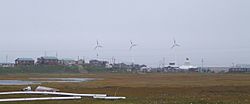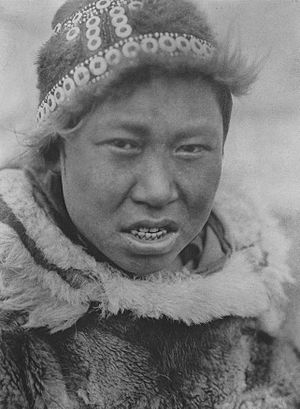Hooper Bay, Alaska facts for kids
Quick facts for kids
Hooper Bay
Naparyarmiut
|
|
|---|---|

Hooper Bay with wind turbines in background.
|
|
| Country | United States |
| State | Alaska |
| Census Area | Kusilvak |
| Incorporated | February 7, 1966 |
| Area | |
| • Total | 7.53 sq mi (19.50 km2) |
| • Land | 7.50 sq mi (19.42 km2) |
| • Water | 0.03 sq mi (0.08 km2) |
| Elevation | 26 ft (8 m) |
| Population
(2020)
|
|
| • Total | 1,375 |
| • Density | 183.41/sq mi (70.81/km2) |
| Time zone | UTC-9 (Alaska (AKST)) |
| • Summer (DST) | UTC-8 (AKDT) |
| ZIP code |
99604
|
| Area code | 907 |
| FIPS code | 02-33470 |
| GNIS feature ID | 1403493 |
Hooper Bay is a city in Alaska, United States. Its name in the local Yup'ik language is Naparyarmiut. In 2020, about 1,375 people lived there. This was an increase from 1,093 people in 2010.
On August 3, 2006, a big fire happened in Hooper Bay. It destroyed about fifteen acres of the city. Thirty-five buildings were burned, including twelve homes, the elementary, middle, and high schools. Stores, offices, and teacher housing were also lost. This fire left 70 people without homes.
Contents
Geography and Climate in Hooper Bay
Hooper Bay is located in Alaska, about 20 miles (32 km) south of Cape Romanzof. It's also 25 miles (40 km) south of Scammon Bay. The city is part of the Yukon-Kuskokwim Delta region.
The city has two main parts. One part is built on gently rolling hills. The other, newer part is in lower, flatter areas.
Land and Water Area
According to the United States Census Bureau, Hooper Bay covers about 8.8 square miles (22.8 square kilometers). Most of this area, about 8.7 square miles (22.5 square kilometers), is land. Only a small part, about 0.1 square miles (0.3 square kilometers), is water.
Hooper Bay's Weather
Hooper Bay has a polar climate. This means that even in the warmest month, the average temperature is only about 49.2°F (9.6°C).
Unlike some polar climates, the ocean helps keep winters from getting too cold. Because of this, the ground doesn't stay frozen all the time (this is called sporadic permafrost). Hooper Bay also gets a lot of rain in late summer, which is more like a subpolar oceanic climate.
The ocean's influence also means there's a lot of snowfall. It often snows more than 4 inches (10 cm) for eight months of the year!
| Climate data for Cape Romanzof LRRS Airport (1961–1990 normals, extremes 1953–1985) | |||||||||||||
|---|---|---|---|---|---|---|---|---|---|---|---|---|---|
| Month | Jan | Feb | Mar | Apr | May | Jun | Jul | Aug | Sep | Oct | Nov | Dec | Year |
| Record high °F (°C) | 49 (9) |
48 (9) |
46 (8) |
60 (16) |
71 (22) |
72 (22) |
79 (26) |
73 (23) |
63 (17) |
60 (16) |
45 (7) |
48 (9) |
79 (26) |
| Mean maximum °F (°C) | 36.8 (2.7) |
33.8 (1.0) |
37.0 (2.8) |
41.0 (5.0) |
53.8 (12.1) |
62.6 (17.0) |
68.0 (20.0) |
64.6 (18.1) |
56.4 (13.6) |
44.3 (6.8) |
38.0 (3.3) |
36.6 (2.6) |
69.9 (21.1) |
| Mean daily maximum °F (°C) | 18.6 (−7.4) |
15.6 (−9.1) |
19.6 (−6.9) |
26.3 (−3.2) |
38.3 (3.5) |
48.1 (8.9) |
52.8 (11.6) |
52.1 (11.2) |
46.5 (8.1) |
34.7 (1.5) |
25.5 (−3.6) |
19.7 (−6.8) |
33.3 (0.7) |
| Daily mean °F (°C) | 13.7 (−10.2) |
10.0 (−12.2) |
14.3 (−9.8) |
20.9 (−6.2) |
34.4 (1.3) |
43.5 (6.4) |
49.2 (9.6) |
49.0 (9.4) |
43.8 (6.6) |
31.2 (−0.4) |
23.2 (−4.9) |
14.3 (−9.8) |
29.0 (−1.7) |
| Mean daily minimum °F (°C) | 8.7 (−12.9) |
5.6 (−14.7) |
9.0 (−12.8) |
16.4 (−8.7) |
29.7 (−1.3) |
39.3 (4.1) |
45.0 (7.2) |
45.4 (7.4) |
40.2 (4.6) |
28.7 (−1.8) |
18.0 (−7.8) |
10.1 (−12.2) |
24.8 (−4.0) |
| Mean minimum °F (°C) | −14.0 (−25.6) |
−14.1 (−25.6) |
−11.7 (−24.3) |
−1.6 (−18.7) |
16.6 (−8.6) |
31.5 (−0.3) |
38.8 (3.8) |
39.2 (4.0) |
32.1 (0.1) |
15.7 (−9.1) |
3.5 (−15.8) |
−9.5 (−23.1) |
−19.6 (−28.7) |
| Record low °F (°C) | −23 (−31) |
−26 (−32) |
−26 (−32) |
−15 (−26) |
3 (−16) |
25 (−4) |
31 (−1) |
33 (1) |
23 (−5) |
4 (−16) |
−15 (−26) |
−23 (−31) |
−26 (−32) |
| Average precipitation inches (mm) | 1.17 (30) |
0.84 (21) |
0.90 (23) |
0.93 (24) |
1.41 (36) |
2.23 (57) |
3.14 (80) |
4.54 (115) |
4.36 (111) |
2.78 (71) |
1.46 (37) |
1.31 (33) |
25.06 (637) |
| Average snowfall inches (cm) | 9.2 (23) |
5.3 (13) |
7.9 (20) |
8.1 (21) |
3.9 (9.9) |
1.0 (2.5) |
0.0 (0.0) |
0.0 (0.0) |
1.1 (2.8) |
9.4 (24) |
9.7 (25) |
10.1 (26) |
65.7 (167) |
| Average precipitation days (≥ 0.01 inch) | 10.9 | 7.3 | 9.9 | 11.3 | 10.8 | 12.1 | 16.3 | 19.9 | 18.8 | 18.2 | 14.6 | 10.8 | 165.9 |
| Average snowy days (≥ 0.01 inch) | 10.4 | 6.6 | 10.2 | 11.0 | 6.1 | 0.6 | 0.0 | 0.0 | 0.9 | 12.0 | 13.3 | 11.1 | 82.8 |
| Source 1: WRCC | |||||||||||||
| Source 2: XMACIS (snowfall) | |||||||||||||
People of Hooper Bay
Hooper Bay first appeared in the U.S. Census in 1880. It was listed as an Yup'ik settlement called Askinuk. Later, in 1890, it was called Askinaghamiut. The name Hooper Bay first appeared in 1930. The city officially became a city in 1966.
Population Growth
The number of people living in Hooper Bay has changed over the years:
| Historical population | |||
|---|---|---|---|
| Census | Pop. | %± | |
| 1880 | 175 | — | |
| 1890 | 138 | −21.1% | |
| 1930 | 209 | — | |
| 1940 | 299 | 43.1% | |
| 1950 | 307 | 2.7% | |
| 1960 | 460 | 49.8% | |
| 1970 | 490 | 6.5% | |
| 1980 | 627 | 28.0% | |
| 1990 | 845 | 34.8% | |
| 2000 | 1,014 | 20.0% | |
| 2010 | 1,093 | 7.8% | |
| 2020 | 1,375 | 25.8% | |
| U.S. Decennial Census | |||
Who Lives in Hooper Bay?
In 2000, there were 1,014 people living in Hooper Bay. Most of the people, about 93.69%, were Native American. About 4.24% were White. A small number of people were of two or more races.
Many households in Hooper Bay have children. In 2000, about 61.7% of households had children under 18. The average household had about 4 to 5 people.
The population in Hooper Bay is quite young. In 2000, almost half of the people (49.2%) were under 18 years old. The average age was 18 years.
Education in Hooper Bay
Students in Hooper Bay go to Hooper Bay School, also known as Naparyarmiut Elicarviat. This school teaches students from pre-kindergarten all the way to twelfth grade. It is managed by the Lower Yukon School District.
The school has a special program. In kindergarten through third grade, students learn in both English and the Yup'ik language. This is the first program of its kind in the school district.
Older students in high school can also choose to attend public boarding schools in Alaska. These include Nenana Student Living Center and Mt. Edgecumbe High School.
Images for kids
See also
 In Spanish: Hooper Bay (Alaska) para niños
In Spanish: Hooper Bay (Alaska) para niños















